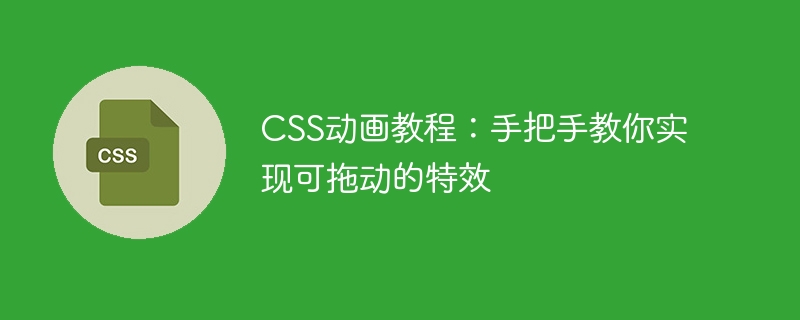Home >Web Front-end >CSS Tutorial >CSS Animation Tutorial: Teach you step by step how to implement draggable special effects
CSS Animation Tutorial: Teach you step by step how to implement draggable special effects
- 王林Original
- 2023-10-18 12:15:11951browse

CSS Animation Tutorial: Teach you step-by-step to implement draggable special effects
In modern web development, animation effects have become an important factor in improving user experience and attracting user attention. one of the important means. CSS animation is a lightweight, simple and easy-to-use method to achieve animation effects. It is often used to achieve transitions, dynamic effects and interactive special effects of page elements. This article will introduce you to a method of using CSS animation to achieve draggable special effects, and give specific code examples.
1. Implementation ideas
To achieve draggable special effects, we need to use the translate() method in CSS and JS to handle the drag event of the element. The specific implementation steps are as follows:
- First, we need to create an HTML element as a draggable object;
- Use CSS to define the style of the element to make it draggable. The appearance of animation;
- In JS, bind a drag event to the element;
- In the handler function of the drag event, use the
translate()method to achieve The position of the element changes.
2. Code Implementation
The following is a specific example that demonstrates how to implement a draggable square. First, we define a div element in HTML with a draggable style:
<div id="draggable"></div>
Then, define the style of the draggable element in CSS:
#draggable {
width: 100px;
height: 100px;
background-color: red;
position: absolute;
top: 0;
left: 0;
cursor: move;
}Next, implement the dragging function in JS:
var draggable = document.getElementById('draggable');
var isDragging = false;
var offset = { x: 0, y: 0 };
draggable.addEventListener('mousedown', function(e) {
isDragging = true;
offset.x = e.clientX - draggable.offsetLeft;
offset.y = e.clientY - draggable.offsetTop;
});
document.addEventListener('mousemove', function(e) {
if (!isDragging) return;
draggable.style.transform = "translate(" + (e.clientX - offset.x) + "px, " + (e.clientY - offset.y) + "px)";
});
document.addEventListener('mouseup', function() {
isDragging = false;
});In the above code, first obtain the draggable element through the document.getElementById() method, and then bind it Define the mousedown event. When the mouse is pressed, set the isDragging variable to true and record the initial position of the mouse and the initial offset of the element.
Next, bind the mousemove event to document. When the mouse moves, if isDragging is true, then Calculate and update the position of the element, and use the translate() method to change the offset of the element.
Finally, bind the mouseup event to document, and when the mouse is released, set the isDragging variable to false , the drag operation ends.
3. Summary
Through the above examples, we can see that using CSS animation and JS, we can simply achieve a draggable effect. In addition to dragging effects, CSS animation can also complete more animation effects, such as transition, rotation, scaling, etc. Mastering the use of CSS animation can add more interactivity and appeal to our web pages. I hope this article can be helpful to you. Interested readers can try to expand more interesting animation effects!
The above is the detailed content of CSS Animation Tutorial: Teach you step by step how to implement draggable special effects. For more information, please follow other related articles on the PHP Chinese website!

